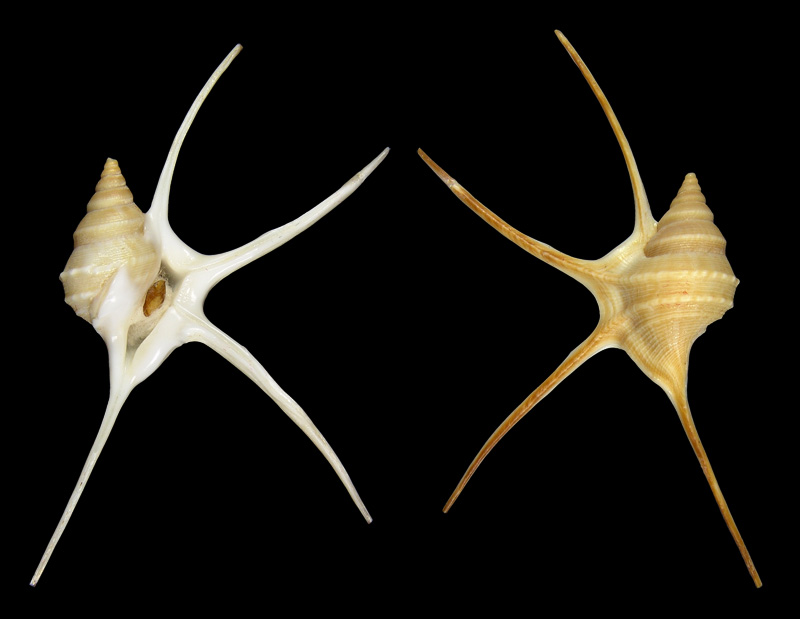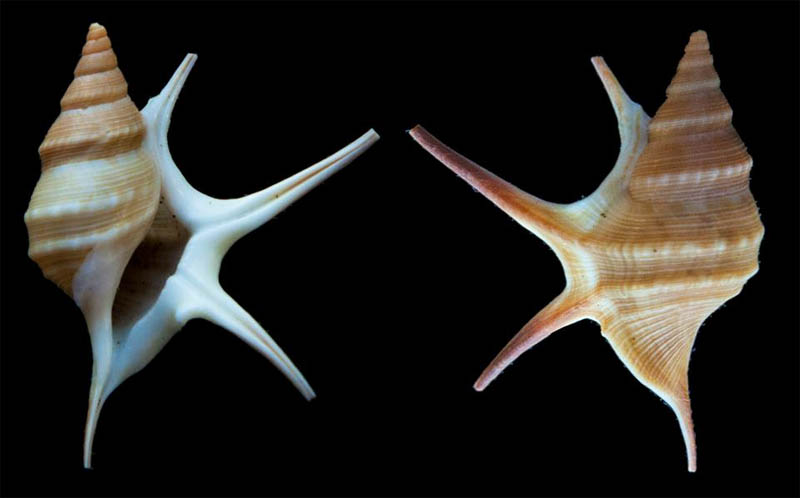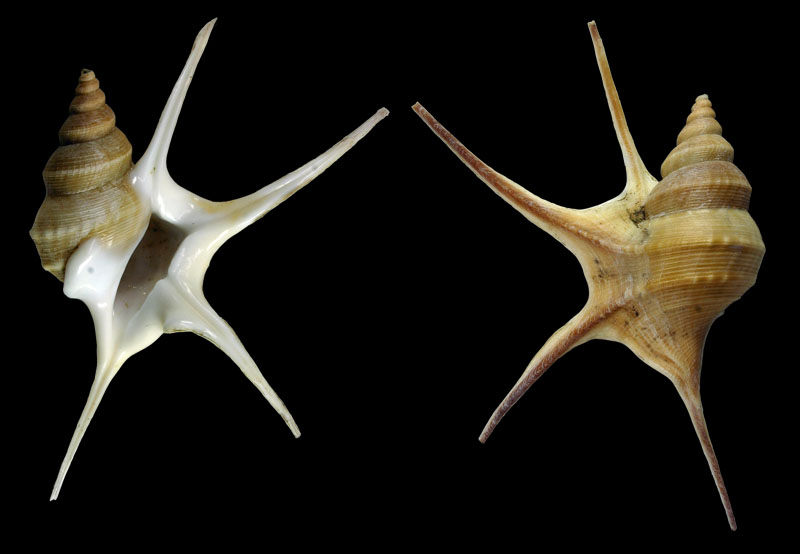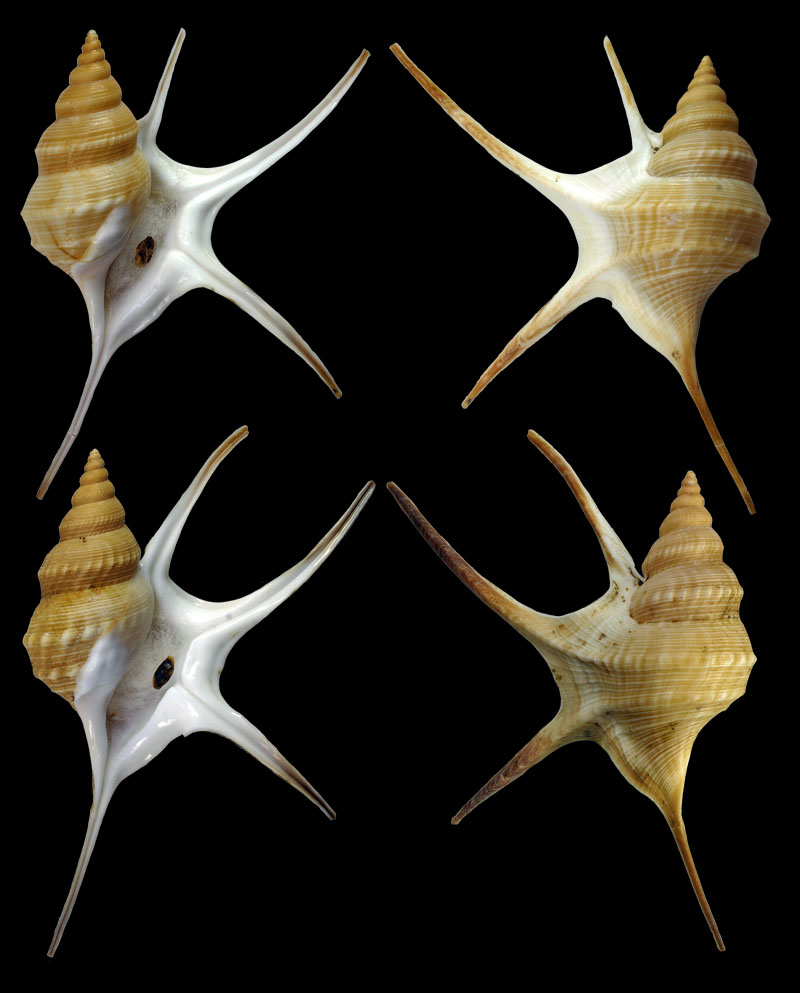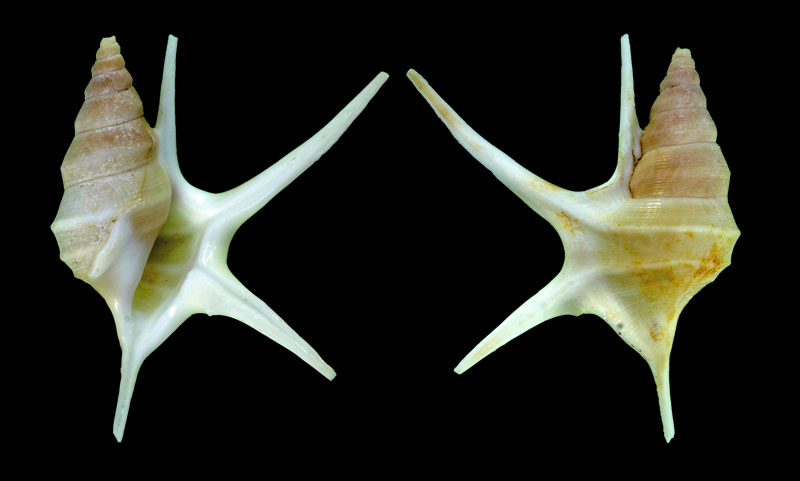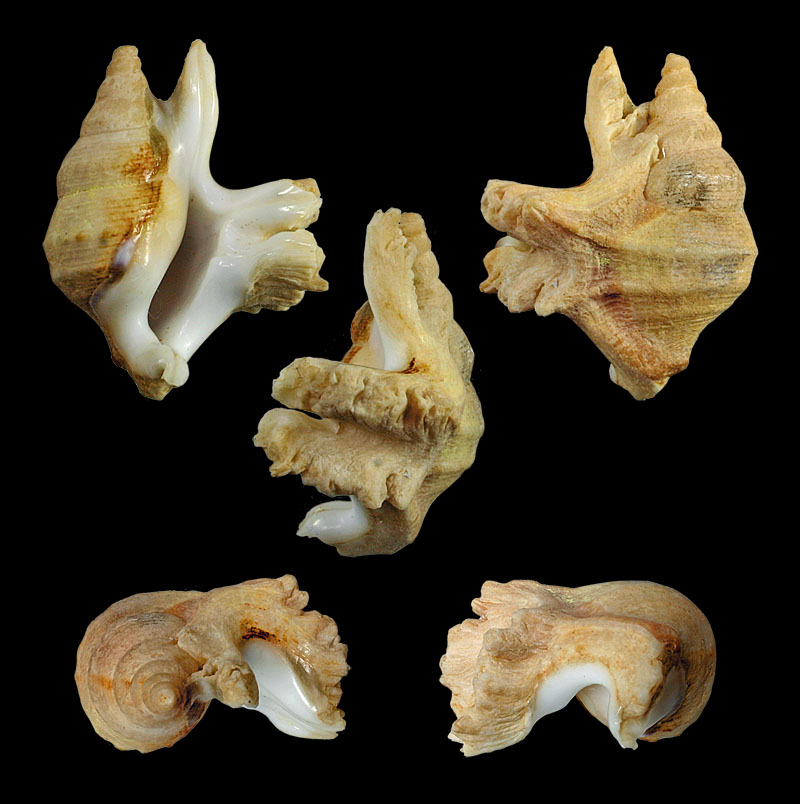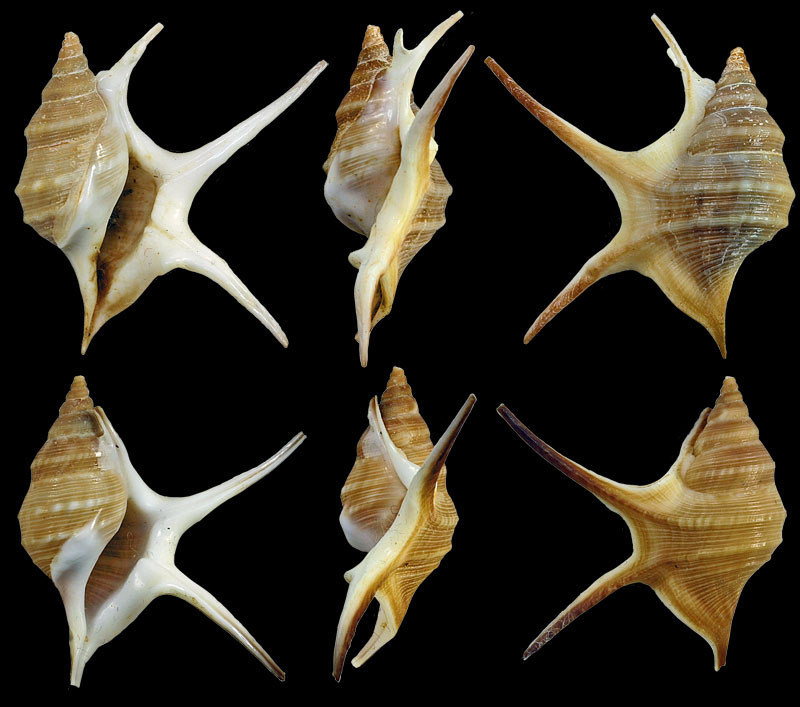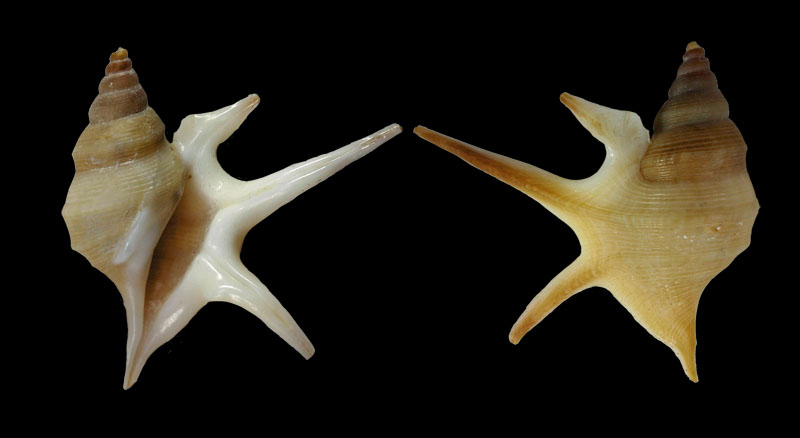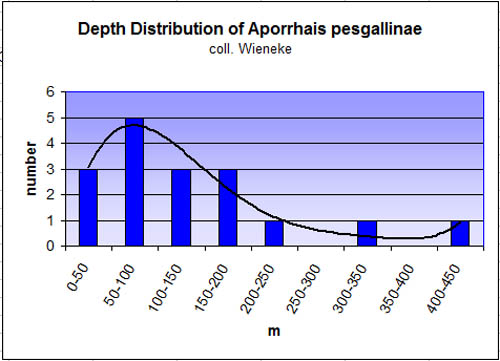|
edit SideBar
|
Species / Aporrhais Elegantissima
Stromboidea
Original Description of Aporrhais elegantissimus by Parenzan, 1970, p. 142:
- "31 mm. Non posso fare a meno di istituire questa nuova specie, perchè, in coerenza ai concetti del Settepassi, che denominò, descrisse ed illustrò tutte le forme fino ad oggi repertate, o quasi tutte, degli Aporrhais, la conchiglia in mio possesso è nettamente diversa da tutte, ed appare, anzi, a caratteristiche più distinte, come riferitò in seguito. Fa parte del gruppo del serresianus, ed ha quattro digitazioni, che però presentano caratteristiche molto diverse dell' A. macandreae, e d'altronde è probabile che non sia specie di profondita perchè è stata raccolta su una spaggia, insieme a matriale di acque basse. Comunque, a parte tale questione (potrebbe esser stata gettata in acqua bassa dai pescatori di ritorno da pescate a profondità maggiori!), le conchiglie dell´A. serresianus presentano il complesso spirale (visto dal lato dell'apertura) snello, con cordoni a tubercoli in generale ben marcati che vanno, salvo eccezioni, fino alla base dorsale - diremo così - delle digitazioni. Nell'esemplare in questione invece il complesso spirale è più largo, e presenta un vistoso callo pericolumellare bianco, porcellanaceo, mentre i detti cordoni presentano i tubercolini poco rilevati, per niente appariscenti, che d'altronde vanno rapidamente estinguendosi verso le digitazioni, ove, specialmente i cordoni maggiori, ne sono del tutto privi. A parte queste caratteristiche, le digitazioni centrali, mölto delicate e sottili, non partono da una 'base', cioè da un'espansione del labbro (cfr. i disegni), bensì da un semplice bordo labiale dal quale inizia subito il caratteristico solco. Se come penso sia per le varie forme, varietà e anomalie del Settepassi: vix-prominens, digitis brevibus, varia, expensa, bifida, sextadigitata, multiplicata e foliacea, che ovviamente possono variare e 'transizionare' (mi si cusi questo termine) infinitamente, anche l´A. elegantissimus dovesse un giorno rivelarsi tale, certo è che differiscono nettamente, nell'esemplare in questione, le caratteristiche, ed è perciò che ho creduto di non eccedere fissando per questa forma 'elegantissima' un nome adeguato."
Locus typicus: "(Marina di Ginosa beach near Taranto, Italy), Senegal. In all probability the type specimen has been transported by fishing boats to the Italian coast
(MIENIS 1976). We here correct the type locality to Dakar, Senegal." (Wieneke & Liverani, 2019)
Type: "PARENZAN (1970) did not designate a specimen as holotype. Since he had only one specimen available (“La conchiglia è stata repertata sulla spaggia di Marina di Ginosa, dalla signora ELENA LA SORSA, che qui ringrazio” PARENZAN 1970: 143), this is considered as type specimen. It is figured in SETTEPASSI (1971 [1977]: pl. 13, fig. 34), MARI (1972: fig. p. 7 upper left) and MALATESTA (1974: pl. 16, fig. 4)." (Wieneke & Liverani, 2019)
History and Synonymy
Aporrhais elegantissima Parenzan, 1970: 142, pl. XXVIII, fig. 560 [as Aporrhais elegantissimus]
- Syn.: Aporrhais pes-gallinae – DA FRANCA, 1967: 5, figs 4, 5.
- Syn.: Aporrhais uttingerianus elegantissimus – MARI, 1972: 7 fig. p. 7 upper left.
- Syn.: Aporrhais (Aporrhais) uttingeriana elegantissima – MALATESTA, 1974: 217, pl. 16, fig. 4.
- Syn.: Aporrhais uttingeriana pesgallinae – MIENIS 1976: 89, fig. 3.
- Syn.: Aporrhais pseudoserresianus procerus SETTEPASSI, 1971 [1977]: xxi, pl. 15, figs 35, 36 [not available, published in a work which does not consistently use binominal nomenclature, ICZN art. 11.4].
- Syn.: Aporrhais serresiana – WALLS, 1980: 35, top figure, left.
- Syn.: Aporrhais serreseanus [sic!] elegantissimus – KARNEKAMP, 1984: 53 [lapsus calami].
- Syn.: Aporrhais uttingeriana pesgallinae – KRONENBERG, 1991: 78, fig. 5, pl. 4, fig. 2.
- Syn.: Aporrhais gallinae MONTEILLET in GIRESSE et al. 1996: 34 [not available, lapsus calami].
- Syn.: Aporrhais uttingeriana – SOLSONA, GILI & MARTINELL, 2000: 89.
- Syn.: Aporrhais (Aporrhais) uttingeriana – MARQUET, GRIGIS & LANDAU, 2002: 158.
- Syn.: Aporrhais pesgallinae – ARDOVINI & COSSIGNIANI, 2004: 97.
- Syn.: Aporrhais uttigerianus [sic!] pesgallinae – DONEDDU & TRAINITO, 2005: 77, fig. 158 [lapsus calami].
- Syn.: Aporrhais pesgallinae – MANGANELLI, SPADINI & FIORENTINO, 2008: 509.
- Syn.: Aporrhais pesgallinae – CASTILLO-ONATE, 2017: 67.
1972
Description of Aporrhais elegantissimus by De Geronimo in Mari, 1972, p. 6:
- Conical, turrited, not very thick shell, constituted by 8 convex whorls with depressed sutur. The whorls by a series of small tubercules; the last whorl presents are covered by many, thin and visible decurrent striae and two series of tubercules and under these, a decurrent thread which is taller than the other ones. Long opening; thin, not too wide outer lip, with three long and thin digitations which are deeply canaliculated; the inside lip has a very wide columellar callosity. Crooked columella. Syphonal-channel (tail) open, slightly curved, narrow and long. Outer-surface grey tending to brown; the digitations and the peristoma are milk-white. Operculum and soft parts unknown. The holotype's height is 31 mm., but it must be more if one considers that the embrional whorls are missing and that the tail is broken."
Mari, 1972, p. 7
- reported Aporrhais elegantissimus from Naudibou, Mauritania
- mentioned that Parenzan proposes that the holotype of Aporrhais elegantissimus might be thrown from fishing boats returning from west African coasts into the italian sea.
- claimed (together with A. Malatesta) that Aporrhais elegantissimus is a surviving descendant of the pliocene mediterranian Aporrhais uttingerianus (Risso, 1826)
1974
Malatesta, 1974, p. 217/218: Aporrhais uttingeriana elegantissima:
- "Parenzan (l.c.) ha descritto un esemplare spaggiato presso Taranto e su di esso ha fondato una nuova specie: A. elegantissimus; successivamente (in 'La Conchiglia', 1972, n° 9-10, 6-7 e figure nel testo) in base ad altri esemplari proveniente dalle coste della Mauritania, è stata accerta la stretta affinità che lega questa forma vivente alla specie fossile del Risso, ritenuta estinta. Morfologicamente essa si distingue, tuttavia, dal tipo pliocenico per la minor estensione della callosità sulla parete interna dell'apertura, per la posizione della digitazione posteriore distaccata dalla spira ed inclinata in senso opposto all'asse della conchiglia e per la direzione della digitazione terminale parallela all'asse della conchiglia, quasi continuazione de essa, e non inclinata. Pertanto essa è stata giustamente valutata come sottospecie della specie fossile: Aporrhais uttingeriana elegantissima Parenzan. E' interessante osservare che tra le forme fossili di A. uttingeriana quella che più si avvicina alla forma vivente è un esemplare calabriano figurato da Cerulli (l.c., fig. 27). G. Barsotti ha esaminato radula ed opercolo della elegantissima ed ha constato che essi differiscono sia da quelli di A. serresiana (Michaud) che da quelli di A. pespelecani, dimostrando l'indipendenza tassonomica delle tre specie. Verrebbe così a cadere l'ipotesi formulata da Sacco della trasformazione di A. uttingeriana 'pliocenica' in A. serresiana 'quaternaria e attuale'. Quest'ultima, tuttavia, potrebbe essersi distaccata dal ceppo della uttingeriana già durante il Pliocene ed aver realizzato un adattamento ai fondi fangosi della zona batiale, con conseguente differenziazione a rango specifico, mentre in zona litorale sopravvivevano popolazioni indifferenziate della forma antenata ed adattata alle condizioni termiche del Neogene, della quale gli ultimi superstiti avrebbero trovato rifugio, con diverse altre specie di tradizione cenozoica, sulle coste dell'Africa occidentale."
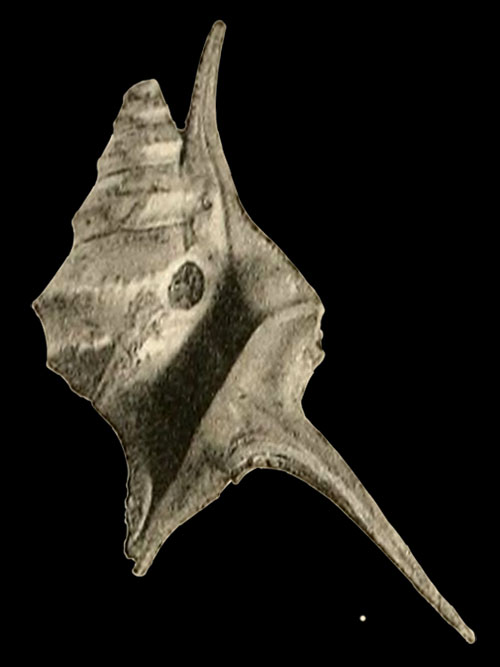 Chenopus uttingerianus in Cerulli, 1911, pl. XXVI, fig. 27
1976
Mienis, 1976
- emended A. elegantissimus to A. elegantissima (p.89)
- placed A. pesgallinae as subspecies of A. uttingeriana: Aporrhais uttingeriana pesgallinae (p. 90).
- cites the following additional localities (p. 92):
- Congo, Pointe Noire, leg. J. Moret, 1969 (ZMA, 1 ex.)
- Congo, Pointe Noire, depth 200-250 m, leg. Vessel André Nizary, ORSTOM, 5.XII.1972 (ZMA, 1 ex.)
- Angola, depth 180 m, muddy sand, 1967 (RNHL 2127, 1 ex.)
1977
- Aporrhais elegantissima Parenzan in Settepassi, 1971[1977]: pl. 13, fig. 34
- Aporrhais pseudoserresianus procerus Settepassi, 1971[1977]: XXI, pl. 15, fig. 35, 36
Settepassi, 1977:XXI:
- "Aporrhais elegantissimus Parenzan (= Aporrhais pesgallinae Barnard)"
- "Secondo il Prof. Henk K. Mienis dell'Università ebraica di Gerusalemme (1) questa forma di conchiglia di Aporrhais, descritta da Parenzan come specie nuove, col nome di A. elegantissmus (2) è l' A. pesgallinae di Barnard (3) attualemente vivente sulle coste atlantiche africane. Parenzan la cita come rinvenuta sulla spaggia di Genosa presso Taranto, Ebreo (4) nell'Arcipelago Toscano. Ha una forma che si avvicina al serresianus per le digitazioni più sottili e delicate del pespelecani, ma l' A. elegantissimus ne possiede tre sottili e più lunghe, oltre la Coda. Il complesso della conchiglia si avvicina aall' Aporrhais uttingerianus, specie estinta. Alcuni malacologi l' elegantissimus lo ritengono un relitto di quest'ultimo, ma io non sono di questo parere, l' uttingerianus è una specie caratteristica, pesante, avendo sempre la prima digitazione aderente al corpo della conchiglia e le digitazioni più ingrossate. Nel Pliocene si rinviene anche una forma, molto rara, dell' uttingeranus peraraneosa (vedi Atlante Tav. 15, fig. 39, e La Conchiglia 1972 N. 9.10, pag. 7)."
1983
Giles & Gosliner, 1983, p. 16:
- Family Aporrhaidae
- Aporrhais pesgallinae Barnard, 1963a: 67, fig. 8.
- Holotype: SAM-A30248. Shell with anomal in alcohol, radula slide..
- Locality: 26°23'S 14°17'E; 311 m; 28 October 1948.
- Collected by: R.S. Africana I.
1984
Karnekamp, 1984, p. 53 placed Aporrhais elegantissima Parenzan into the synonymy of Aporrhais serreseanus [sic]:
- "A. ser. elegantissimus Parenzan = slanke vorm van de soort"
1989
Forli, 1989:49:
- "In the case of Aporrhais uttingeriana and its pleistocenic forms I think one can advance two hypotheses. The first suggests the extinction of the species in the Mediterranean, represented by forms near to A. uttingeriana pesgallinae, during the Lower Pleistocene. These forms survive in the Atlantic where they acquire the features typical of the actual subspecies. The other hypothesis, which in my opinion is more plausible, and which also involves the substitution of A. uttingeriana by A. serresiana, suggests the extinction of A. uttingeriana in the Mediterranean during the course of the Pliocene and its re-introduction during warm periods during the Lower Pleistocene, with those forms, originally from the Atlantic, which are so close to A. uttingeriana pesgallínae that they are, as far as I can see, the prevalent variety of A. uttingeriana in the Pleistocene. In this situation I interpret the substitution of A. uttingeriana by A. serresiana. A. serresiana, generated in the Atlantic, having penetrated occasionally during the Pliocene into the Mediterranean where it is very rare, in concomitance with cold climate oscillations substitutes the typical A. uttingeriana, and gradually asserts itself in the deep facies. It is at the end of the Lower Pleistocene that A. uttingeriana becomes extinct in the Mediterranean and, like many other molluscs from the Mediterranean Pliocene, actually survives to day along the coasts of Western Africa with a subspecies: Aporrhais uttingeriana pesgallinae. On this subject (from Malatesta - Mal. Plioc. Umbra. p. 218): “Pareazan has described a specimen beached near Taranto and has founded a new species on it: A. elegantissimus; successively, on the basis of other specimes coming from the coast of Mauritania, a close affinity has been ascertained which links this living form with a fossile species of Risso, which is considered extint. Morphologically this can be distinguished from the pliocenic type by the minor extension of the callosity on the internal face of the aperture, and by the position of the posterior digitation which is detached from the spire and inclined in the opposite direction from the axle of the shell, almost in continuation of it and not inclined. Therefore it has been rightly judged as a subspecies of the fossil species: A. uttingeríana elegantissimus Parezan. It is interesting to observe that among the fossil forms of A. uttingeriana, the one that is ñearest to the living form is a Calabrian specimen, represented by Cerulli (op. cit. p. 27)”. A. elegantissimus Parenzan, 1970, being a synonym for A. pesgallinae Barnard, 1963, the name of the subspecies is therefore A. uttingeriana pesgallinae. There are therefore specimes of pleistocenic A. uttingeriana which present morphological characteristics part way between the typical A. uttingeriana and its subspecies. In a deposit with abundant specimes of Arctica islandica L. 1767, in the province of Livorno attributed to a vague Lower Pleistocene, I myself have found a specimen very similar to that represented by Cerulli, showing the posterior digitation as elongated and not far from the spire, which is a marked feature in A. uttingeriana pesgallinae. In conclusion of the point, I believe we can state that from miocenic forms with delicate labial digitation and short posterior digitations attached to the spire, perhaps related to C. meridionalis var taurinensis, passing through the pliocenic A. uttingeriana, with adherent posterior digitations in length equal to or slightly more protruding than the spire, (even if, for exemple in Sacco’s var peraraneosa the digitations are much longer), and through pleistocenic specimens with posterior digitations which are more developed in length and not far from the spire, we arrive at A. uttingeriana pesgallinae which shows elongated posterior digitation detached from the spire and inclined in the opposite direction. There are, as already stated, other differentiating features, but the form and disposition of the digitations is the most evident. Among other things there is a perfect correspondence of habitat between the pliocenic form of A. uttingeriana and its actual subspecies."
1991
Kronenberg, 1991, p. 78 gives
- depth, where Aporrhais uttingeriana pesgallinae lives: from 100 to at least 350 m.
- measurements: up to 40 mm (if the first digit is included up to 50 mm)
- localities:
- "Western Africa; Mauretania / Senegal and Angola / Namibia."; "no live record from the Mediterranean is known."
- Luanda, Angola, trawled, depth 50m. (p. 78)
- Angola, offshore, muddy sand, depth 180m (p. 82)
1996
Giresse et al. report Aporrhais gallinae [error pro Aporrhais pesgallinae] from Cameroon.
- p. 34: "Aporrhais gallinae vase du large"
2000
Solsona et al., 2000:
- p. 86: "Following Mienis (1976) and Kronenberg (1991), we considered that the present species A. pesgallinae Barnard, 1963 and A. elegantissima Parenzan, 1970, both from western Africa, are synonyms of A. uttingeriana."
- p. 90: "At Present, A. uttingeriana is to be found in the coasts of Mauritania and Senegal and along the coasts of Namibia and Angola, but it seems it is not found between these areas (Fig. 3). If the absence of A. uttingeriana between Senegal and Namibia is certain, and not due solely to a lack of data, this would mean that this species has a disjunctive distribution."
2001
Harzhauser, 2001, p. 59:
- "Stromboidea have proved to be excellent marker fossils for palaeoclimatic changes in Neogene. A well-known example is Strombus (Lentigo) latus GMEL. which evolved from the Miocene to Pliocene Strombus (Lentigo) bonelli/coronatus group, ubiquitous at that time throughout the entire Mediterranean. During the Pleistocene climatic deterioration, Strombus latus became extinct in the Mediterranean but found a refuge along the western coast of Africa. However, in the course of the Pleistocene climatic optima, Strombus latus managed to re-enter the Mediterranean Sea in short waves (CORNU & al. 1993, RÖGL & al. 1996/97). Similarly, Aporrhais uttingerianus (RISSO) experienced a drastic reduction of its distribution-area from the Middle Miocene to the Recent. The species was well established in the Mediterranean Sea during the Neogene but shifted its northern boundary to lower latitudes in the Quaternary and is restricted to the western coast of Africa today (SOLSONA & MARTINELL 2000)."
2002
Marquet, Grigis & Landau, 2002 lump the Mediterranean Tortonian forms and the Paratethyan Badenian forms together with the recent morph [Aporrhais pesgallinae] and use the name Aporrhais (Aporrhais) uttingeriana.
- p.158: "Large species, with four to five well developed, long and pointed digitations, except for the adapical one, which is small and fused with the spire. It charcteristically forms an angle of more than 100° with the second digit."
Sasaki, 2002:74
- RM28314. Aporrhais pesgallinae Barnard, p. 74, fig. 2-29A.
2008
Manganelli et al. 2008, p. 509:
- "A. pesgallinae differs from A. uttingeriana by virtue of its more delicate structure, an adapical digitation diverging proximally from the spire ( in A. uttingeriana the adapical digitation only rarely diverges from the spire and when it does, it diverges distally) and a shorter, thinner abapical digitation usually less divergent from the axis"
Specimens from private collections
Aporrhais uttingeriana pesgallinae Barnard, 1963; off Quicombo Bay, Angola, Southern Africa; 11° S 13° E; trawled by Belgian fishermen (PEMARCO: Pêche Maritime du Congo), on sandbar; depth: -175 m; 1965; 77.2 mm; Coll. Frank Nolf
Aporrhais pesgallinae Barnard, 1963; Guinea-Bissau, West Africa; 38 mm; Coll. Chong Chen
Aporrhais pesgallinae Barnard, 1963; off Faro das Lagostas, near Luanda, Angola, Southern Africa; trawled from 30-35 m; 56,5 mm; Coll. Ulrich Wieneke
- Comment: Morph similar to the type of Aporrhais elegantissima
Aporrhais pesgallinae Barnard, 1963; off Port Bouet, Abidjan, Ivory Coast, West Africa; taken in net in 80 m; 1997; Coll. Ulrich Wieneke
- t: 48,3 mm; No. 804
- b: 56,2 mm; No. 805
Aporrhais pesgallinae Barnard, 1963; North of Walfis Bay, Namibia, Southern Africa; trawled by fishermen; 39,2 mm; Ex-coll. D & M. Meyer; Coll. Ulrich Wieneke
Aporrhais pesgallinae Barnard, 1963; freak; off Conakry, Guinea, West Africa; by fisherman from 50-70 m; 29,4 mm; Coll. Ulrich Wieneke no. 1971
Aporrhais pesgallinae Barnard, 1963; freak; Guinea-Bissau, West Africa; from 100 m; Coll. Ulrich Wieneke
- a: 31,6 mm
- Freak with additional spine in posterior position
- b: 34.5 mm
Aporrhais pesgallinae Barnard, 1963; freak; Casamance, Senegal, West Africa; from 80 m; 28,4 mm; Coll. Ulrich Wieneke no. 1396
Localities
Coll. Ulrich Wieneke (total 101 specimens)
- Morocco, from fisherman, 1984, 31,8 mm, 1 specimen
- Mauritania, offshore, trawled by fisherman at 300-600 m, 5.1997, 3 specimens, no. 906-908
- North Angola, offshore at 120 m, dredged on rocky bottom, 2 specimens
- Quicombo, Angola, trawled at 100 fathoms (180 m), Belgian fisherman, 1972, 9 specimens, no. 1841-1851
- off Farol das Lagostas, Luanda, Angola, trawled at 30-35 m, 3 specimen, no. 740, 1120, 1121
- Angola, 1 specimen, no. 672
- Baia de Quizombo, 350 km south of Luanda, Angola, sand, at 30-40 m, 3.2010, 34 specimens
- Casamance, Senegal, at 80 m, 2 specimens, no. 1394, 1395
- Casamance, Senegal, from fisherman, 1990, 3 specimens, no. 736-738
- Dakar, Senegal, 12 specimens, no. 730-733, 741, 784, 1396-1398, 2285-2287
- Dakar, Senegal, dredged at 100 m, 2 specimens, no. 734, 735
- Dakar, Senegal, collected by local fisherman, 200, no. 1341
- Dakar, Senegal, at lowtide, 1 specimen, no. 1336
- Dakar, Senegal, taken by fishermen nets, 4.2000, 1 specimen, no. 1342
- North of Walfis Bay, Namibia, trawled by fishermen, 6.1976, 3 specimens, no. 2541-2543
- South of Walvis Bay, 25°S 12°E, Namibia, trawled at 175 m, on sandbar, 2 specimens, no. 1805, 1923
- Namibia, trawled at 400-450 m, 2 specimens, no. 2526, 2527
- Vridi Canal, off Abidjan, Ivory Coast, trawled at 50-60 m, by local fisherman, 1.1994, 1 specimen, no. 952
- Vridi CBay, Ivory Coast, trawled at 80 m, 9.1998, 2 specimen, no. 874, 875
- Abidjan, Ivory Coast, trawled at 30-50 m, 2.2000, 3 specimens, no. 876-878
- Abidjan, Ivory Coast, bought from local fisherman, 8.1997, 1 specimen, no. 739
- off Port Bouet, Ivory Coast, taken in net at 80 m, 8.1997, 2 specimens, no. 804, 805
- Guinea-Bissau, at 180 m, 1994, 1 specimen, no. 964
- off Guinea-Bissau, trawled at 180 m, 1989, 2 specimens, no. 1349, 1350
- Conakry, Guinea, trawled by fishermen at 50-60 m, 5.1997, 1 specimen, no. 1971
- Conakry, Guinea, trawled by fishermen at 50-60 m, 10.2002, 1 specimen, no. 1961
- Guinea-Bissau, at 100 m, 2 specimens, no. 2524, 2525
- Guinea-Bissau, at 200 m, 3 specimens
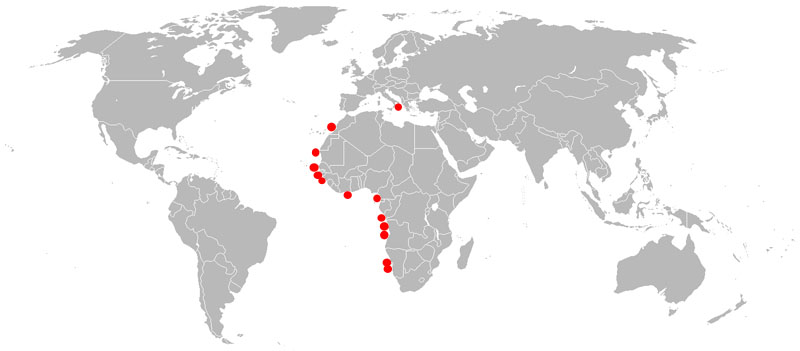 Distribution map of Aporrhais elegantissima
Comment
- The distribution is impacted (besides biological and enviromental parameters) by
- sampling (the deeper, the harder to fish)
- measuring the depth (how trustworthy are the data)
References
- Ardovini R. and Cossignani T. (2004). West African seashells: including Azores, Madeira and Canary Is. L'informatore piceno, Ancona, 318 pp.
- Barnard, 1963
- Bruynseels, 1977 b
- De Lourdes Paes Da Franca, 1967
- P. Giresse, J.-P. Megope-Foonde, G. Ngueutchoua, J.-C. Aloisi, M. Kuete & J. Monteillet, 1996. Carte Sédimentologique du Plateau continental du Cameroun à 1 : 200 000. Éditions de l'ORSTOM, INSTITUT FRANÇAIS DE RECHERCHE SCIENTIFIQUE POUR LE DÉVELOPPEMENT EN COOPÉRATION, COLLECTION NOTICE EXPLICATIVE N° 111, PARIS - 1996.
- Gofas S., Afonso J. P. and Brandào M. (1985). Conchas e moluscos de Angola= Coquillages et mollusques d'Angola [Shells and molluscs of Angola]. Universidade Agostinho, Elf Aquitaine Angola, Angola.
- Kermarrec-Labisse, 1969
- Kronenberg, 1991
- Manganelli, G. Spadini, V. Fiorentino, V., 2008. The lost Aporrhais species from the Italian Pliocene: A. peralata (Sacco, 1893) (Gastropoda, Caenogastropoda), Journal of Conchology, 39(2008), 5, 493-516.
- Mari, 1972
- Marquet, Grigis & Landau, 2002
- Mienis, 1976
- Parenzan, 1970
- Poutiers J. –M. (2016a). Gastropods. In: Carpenter K. E and De Angelis N. (eds.) The living marine resources of the Eastern Central Atlantic. Vol. 2: Bivalves, gastropods, hagfishes, sharks, batoid fishes and chimaeras. FAO Species Identification Guide for Fishery Purposes, Rome, FAO. Pp 907–1115.
- Sasaki, T., 2002: A Natural history of shells., pp. 1–194, pls. 1–16. The University Museum, The University of Tokyo. (in Japanese)
- Settepassi, F. 1967-1972 [1970-1985]. Atlante malacologico dei Molluschi marini viventi nel Mediterraneo, 3 vols., pages numbered separately through each section, with plates, Museo di Zoologia del Commune di Roma, Roma: Tipografia INIVAG, Vol. 1:296 p., 121 pls. 1967 [1970]; Vol. 2:304 p., 96 pls., 1971 [1977]; Vol. 3: unnumbered progressively pages and plates, 1972 [1985], completed and published posthumous by A. Gaglini.
- Wieneke, U. & Liverani, V. 2019. Review of the Recent Endemic West African Aporrhaidae (Gastropoda: Stromboidea), with the re-establishment of Aporrhais elegantissima PARENZAN, 1970 and records of putative hybridization in the genus Aporrhais; Conchylia 50(1-4), 147-162
|


